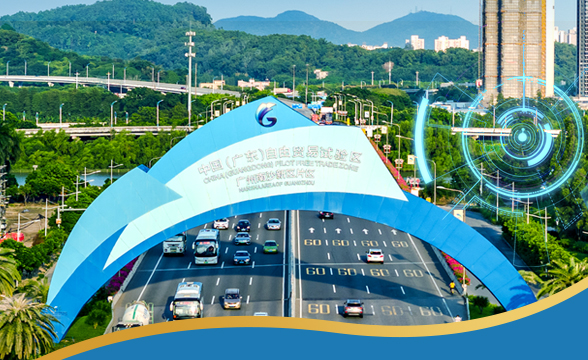Bay Area gearing up for a wider branding of global investors
With a new foreign investment law in place on the Chinese mainland, experts see an uptick in the inflow of a bigger sphere of overseas investors to the Bay Area. Chai Hua reports.
Foreign companies and investors in the early 1980s swarmed to the Pearl River Delta area - the window of China's reform and opening-up - and many of them reaped the benefits of the historic opportunity.
Recently, about four decades later, national authorities started a new round of opening-up with the launch of the recently approved foreign investment law and, at almost the same time, released the integrative development plan of the Guangdong-Hong Kong-Macao Greater Bay Area.

The Bay Area encompasses nine cities in South China's Guangdong province, in addition to the Hong Kong and Macao special administrative regions.
Economic experts predict a new upsurge of foreign investment is expected to follow, similar to 40 years ago, but this time, new protagonists are emerging on the stage.
There is also a division of opinion among executives of foreign companies. Some have already taken bold action, while others are still waiting to see the benefits of the new law and the Bay Area plan.
Governments in the Bay Area are also collaboratively promoting themselves to other nations. The Hong Kong Special Administrative Region led a group of foreign diplomats and business representatives from more than 20 countries and regions who visited the Bay Area in March.
Linda Lau, one representative of the group and deputy director of the Indonesia Chamber of Commerce in Hong Kong, told China Daily the chamber itself has decided to organize a trip in July, to take domestic entrepreneurs from communications, real estate, manufacturing and many other industries to visit the Bay Area.
She said it will be an in-depth tour of an elite team with selected members. "We hope to help these businessmen know more about the latest development of the zone and inspire cooperation to find potential business opportunities together in the future," she said.
Government co-promotion to foreign investors is proceeding at a brisk pace. Less than one month later, the governments of Guangdong, Hong Kong and Macao organized the first joint overseas promotion of the Bay Area in Japan.
Cathy Jiang, partner of the tax and China business advisory service at PwC, said she believes "the speed and quantity of foreign investment will remarkably increase in the Bay Area".
"One reason is the area has the foundation to stand out in the new round of opening-up because about half of overseas investments during the last 40 years were from Hong Kong and Macao, and most of them are in Guangdong," she said.
She estimated that investment from the US, Japan and European countries to Guangdong have surged by 50 percent to 90 percent in 2018.
One particular country she pointed out is Sweden, whose investment in the Bay Area rose by 12 times last year.
In addition, the area's development is also stimulated by the combined effects of the Foreign Investment Law and Bay Area blueprint, she said.
The central government in February released an outline development plan to make the area a world-class science and technology innovation center.
In the following month, the 13th National People's Congress approved a foreign investment law, which will replace three previous laws regulating foreign-invested entities, including the Chinese-foreign equity joint ventures, Chinese-foreign cooperative joint ventures and wholly foreign-owned enterprises.
The new law abandoned the required examination and approval needed to set up each foreign-invested enterprise in China - a system that had been set up in the early 1980s.
"The new foreign investment law is expected to provide a more-fair business environment with the largest extent of openness, such as more-flexible funding management and intellectual protection," Jiang said.
Shift to new sectors
Cao Zhongxiong, executive director of New Economy Research Center at the China Development Institute, a Shenzhen-based think tank, said, "The main battlefield of overseas investment will shift from low-level and labor-intensive industries to technology innovation, emerging industries and high-end manufacturing, such as new materials, biomedicine and chip design."
Foreign investors used to come to Guangdong for manufacturing clothes, daily necessities and toys, as well as assembling electronic production, taking advantage of cheap labor.
Cao also believes the potential will rise in those sectors, such as aircraft production, that have not yet appeared in the Bay Area.
European aerospace giant Airbus in February set up an innovation center in Shenzhen, the company's first one in Asia and second worldwide following the one it had set up in Silicon Valley.
The company has brought its aircraft to the Chinese mainland market since 1980s, but with the launch of the center, Airbus' local partners have extended from China's aviation giants to innovative startups.
The center focuses on the design, testing and certification of new technologies in the key areas of hardware, cabin experience, connectivity, manufacturing innovation and urban air mobility.
For instance, it launched new cabin screen production in hand with Royole Corp, a Shenzhen-based startup of flexible displays.
Cao believes the form of innovation center is becoming mainstream for foreign companies. "Local engineers and production managers with rich and practical experiences of intelligent manufacturing are also a valuable asset for them," he said.
He suggested overseas companies set up such centers in relatively developed cities, such as Hong Kong, Shenzhen and Guangzhou, while other cities in the area are more suited for building a global high-end manufacture base.
Impact on global strategy
Jiang from PwC said international enterprises should even reconsider their global layout strategy, such as relocating their respective regional headquarters to the area.
"With the full implementation of a new VAT (value-added tax) law, the inter-company charges no longer have turnover tax leakage, so there is one thing less to worry about," she added.
The service sector in particular has a huge potential, she said. "The percentage of service sector in the bay area around Tokyo, San Francisco and New York is about 80 to 90 percent, while the ratio here is about only 50 percent," Jiang said.
The analyst believes service providers in Hong Kong should leverage the opportunities.
Another opportunity for the SAR is intellectual property services. She said Hong Kong has sufficient original intellectual properties, but is lack in industrialization for them, so IP in Hong Kong could commercialize in Guangdong and then return to Hong Kong's capital markets, or overseas markets connected to the city, to grow bigger.
However, Christian Ewert, president of Brussels-based Amfori, a trade association of over 2,000 retailers and importers from more than 40 countries, said there is a lot complexity to the changes, and it needs time to digest it all.
He acknowledged that Amfori's members have a growing interest in the area but stressed it is still too early for them to make a major strategy adjustment.
"Promising is one thing, but putting them into practice is another," he said, adding that he believes it will take at least six to 12 months to see actual benefits.
Contact the writer at grace@chinadailyhk.com
(HK Edition 05/17/2019 page8)
All rights reserved. Presented by China Daily










